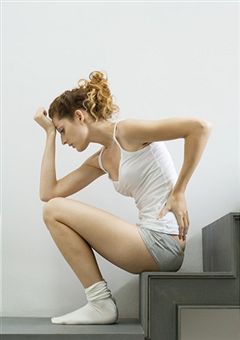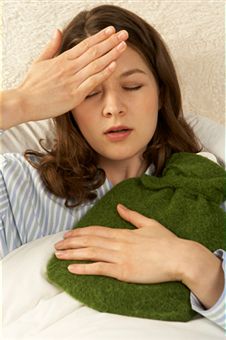Premenstrual Syndrome

Premenstrual Syndrome, also nicknamed “PMS,” encompasses a whole host of physical, emotional, and mental symptoms affecting women. These symptoms relate to the biological menstrual cycle of women. Symptoms can range from being relatively painless to severely impacting the day-to-day lifestyles of millions of women every day.
Alternative Names
Symptoms of Premenstrual Syndrome can fall under multiple categories and names for other illnesses. Sometimes, a woman may mistakenly believe a severe disease, illness, or cancer, is merely a symptom of Premenstrual Syndrome.
Other names for Premenstrual Syndrome are Premenstrual Dysphoric Disorder (PMDD) and Premenstrual Tension Syndrome (PTS). Premenstrual Dysphoric Disorder (PMDD) is a psychiatric disorder that may underly many symptoms of Premenstrual Syndrome (PMS).
Symptoms
As stated, the symptoms for Premenstrual Syndrome (PMS) are wide-ranging. Symptoms typically fall under the category of PMS if they arrive within the second half of the menstrual cycle. This would be 14 or more days after the first day in which the menstrual cycle begins. Symptoms can also be deciphered as PMS if they disappear for around 7 days after the menstrual period ends, and then begin again next month within the second half of the menstrual cycle.
PMS? Get Remedies Fast!
To further discuss the symptoms of PMS, this article will address first address the most common symptoms collectively experienced by women. Next, this article will discuss in depth the specific symptoms that full under three separate categories: Physical symptoms, Psychological symptoms, and Emotional symptoms.
Common Symptoms
Commonly, women experience a variety of symptoms together within the second half of the menstrual cycle. For example, many women report experiencing a headache along with feet swelling, tender breasts, and nausea. Women may also experience mood swings, severe cramps in muscles, and change in sexual arousal. All of these symptoms are fairly common and normal within women in the days before they receive their period. Over 85% of women are said to experience premenstrual symptoms throughout their lifetimes (Davis 2005).
Typically, when menstruation begins women will stop experiencing common symptoms of Premenstrual Syndrome (PMS).
A specific list of symptoms includes the following
- Headache
- Bloating
- Breast Tenderness
- Weight Gain
- Swelling in face, ankles, feet, and hands
- Aching in the back
- Cold sores (sometimes recurring)
- Heaviness
- Abdominal pain
- Abdominal cramps
- Gaseousness
- Light and noise sensitivity
- Food cravings
- Acne
- Diarrhea and constipation
- Lack of coordination
- Muscle spasms
Additional and less common symptoms

- Depression
- Panic and anxiety
- Lack of ability to concentrate
- Poor discernment and judgment
- Forgetfulness
- Irritability
- Aggressive behaviors
- Fatigue
- Sluggishness
- Increased or decreased sex drive
- Decreased self-esteem
- Negative self image
- Paranoia
- Increased fear
- Anti-social behaviors
Causes
The cause of Premenstrual Syndrome (PMS) has never been specifically identified. Doctors do believe PMS can be attributed to a host of biological, cultural, social, and psychological variables. As women approach later years in life during their 30s and 40s, PMS symptoms may also become more severe as women transition into the menopausal stage of life.
Among these host of cases are the following
Changes in the Hormonal Cycle and System
When hormones fluctuate and change, then symptoms of PMS may also change. In other cycles like pregnancy and menopause, PMS symptoms may completely disappear. Changes in gonadal hormones and brain chemicals can affect PMS symptoms, however researchers are still working to discover the exact role of these hormones and chemicals. Gonadal hormones is simply the name for progesterone or estrogen. When women respond abnormally to progesterone, which impacts PMS symptoms more than estrogen, then they may experience PMS symptoms.
Changes in the Hypothalamic-Pituitary-Adrenal (HPA) System can also cause women with PMS symptoms to be more sensitive and experience more intense symptoms. The HPA system is also known as the HPA axis. This axis is a highly important part of the neuroendocrine system. The HPA axis and neuroendocrine system directly control stress levels, regulate emotions and sexual appetite, digestion, the immune system, and many other important bodily functions.
Essentially, the HPA axis helps control reproduction, ensure high self-esteem, and a normal appetite. Many neurotransmitters and hormones help the HPA axis to effectively communicate with the rest of the body. When these neurotransmitters and hormones are somehow disrupted, they can cause fluctuations in the PMS symptoms that women experience. Disruptions may also cause women to experience Premenstrual Dysphoric Disorder (PMDD).
Neurotransmitters
Specifically, there are two neurotransmitters important in protecting women from experiencing severe PMS symptoms. These neurotransmitters are serotonin and gamma-aminobutyric acid (GABA). Properties within these neurotransmitters allow them to effectively protect women, however, when women are lacking in these brain chemicals, they may find themselves experiencing PMS symptoms or severe PMS symptoms.
There is more research being conducted that argues it is the varying levels of these hormones when combined, and not individually, that impact the menstrual cycle of women. The cyclic fluctuations of the overall system can impact the PMS symptoms women experience.
Depression
Women with a family history of depression are more likely to experience severe PMS symptoms. Women with histories of postpartum depression and affective mood disorder may also experience PMS symptoms.
Sensitivity to Insulin
Following ovulation, many women tend to be sensitive to insulin. The sensitivity of insulin may directly impact the low blood sugar levels within women, which then can cause PMS symptoms according to medical researchers.
Prostaglandins
Prostaglandins is a type of bodily chemical made by every cell in the body. This chemical has also been linked to PMS symptoms experienced by women like fluid retention, depression, irritability, and tenderness of the breasts.
Aldosterone
Aldosterone is a hormone originating in the adrenal gland. With higher levels of aldosterone, which is commonly experienced after ovulation, women may experience PMS symptoms like tender breasts, swelling of the breasts, and retention of fluids.
History of Reproduction
Women with a history of having had at least one child are more likely to experience PMS symptoms.
Age
Women between their 20s and 40s are more likely to experience the symptoms of PMS
Stress
Increased stress levels can intensify the PMS symptoms experienced by women.
Poor Diet
A poor diet has been thought to directly contribute to the intensity and kinds of PMS symptoms experienced by women. Sometimes, a diet lacking nutritious vitamins and minerals can lead to intensified PMS symptoms. Also, eating “junk food” like soda, candy, and greasy foods, may also aggravate the Premenstrual Syndrome symptoms women have to face.
Risk Factors
The risk factors for PMS are very similar to the potential causes of PMS symptoms.
Factors that increase the risk of experiencing PMS are the following
- Family History (including Depression, Bipolar Disease, and Postpartum Depression)
- Age
- High stress levels
- Poor nutrition
- Absence of exercise
- Lack of certain vitamins and minerals (B6, calcium, magnesium)
- Other psychological problems
- High anxiety
Prevention Tips
There are many ways women can try to control the PMS symptoms they experience and the length those symptoms last. Some of the best ways to control PMS should be everyday habits. Some doctors and psychologists recommend that women track PMS symptoms in a journal, so they are able to notice how their cycle changes. There are also changes in lifestyle that can influence PMS, in addition to home kit and treatment options.
Eating a proper diet and consuming proper vitamins and minerals can help control PMS. In particular, women may find it helpful to take daily supplements of vitamin B6 (50mg to 100mg) and calcium. These nutrients both help the endocrine system to function at its best. Calcium can induce relief, while B6 can improve depression effects.
Reducing one’s caffeine, sugar, and sodium intake can also help decrease the effects of PMS. Eating a diet of fresh vegetables and fruits helps women receive the nutrients they need. Increased levels of fiber, in particular, can help relieve PMS symptoms. In addition, women should make sure they receive adequate rest and exercise in trying to prevent PMS.
Test and Diagnosis Connsiderations
Women should call a doctor when PMS symptoms escalate and make life unbearable. If women are unable to carry on with day-to-day activities, then they should make an appointment with a doctor to run the appropriate tests.
Other significant PMS symptoms like depression may be recurring, and require medication. A doctor will know the appropriate medication to provide.
Women may wish to consult with other health professionals, such as a gynecologist, nurse practitioner, physician assistant, and family medicine doctor. A psychologist may also be beneficial in aiding with Premenstrual Dysphoric Disorder (PMDD) and managing stress created by PMS.
Tretment Options
Doctors may be able to prescribe medical treatments for women with PMS. There are certain medications that can lower the impact of symptoms and help women achieve balance in their menstrual cycle. Because the hormonal systems of women vary,
A doctor may prescribe any one of the following for a unique PMS case
Birth Control Pills like Yaz
Birth control is an easy way to regulate PMS. Oral contraceptives can stabilize emotions. Yaz has become particularly popular among women seeking to ease PMS. Yaz is a birth control pill that contains progestin drospirenone. Progestin drospirenone has proven to be a highly effective chemical in relieving women from PMS symptoms.
Anti-Depressents
Anti-depressents can help reduce sleep problems, fatigue, and food cravings among women. Doctors will know the specific anti-depressent to prescribe women. Some women may find they only need to take anti-depressents in the two weeks before a period. Doctors may prescribe any one of the following: serotonin reuptake inhibitors (SSRIs), sertraline (Zoloft), or naroxetine (Paxil).
Nonsteroidal anti-inflammatory drugs (NSAIDs)
Nonsteroidal anti-inflammatory drugs contain household prescription drugs like Advil, Motrin, Aleve, and others. NSAID’s can help lessen breast discomfort, sleep deprivity, and muscle cramps when taken before a period begins.
Warm Baths
A warm bath can help ease muscle cramping for women. Warm blankets may also help women sleep better and relieve stress at the onset of a period.
Green Tea
Hot, green tea can also comfort and soothe women during PMS. Green tea may also lower estrogen levels in women which helps women deal with PMS. Lower estrogen levels can help the endocrine system to function in a more efficient manner.
Balanced Diet
Lowering salt and sugar intake during PMS can help women experience less intensified symptoms. In addition, women should seek to consume whole grains, vegetables, fruits, and water.
Exercise
Exercise may help women to release built-up stress and may act as an emotional catharsis during PMS.

No Comments